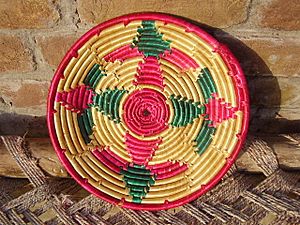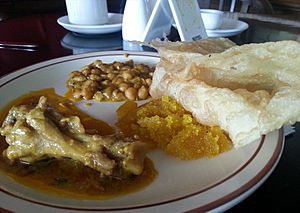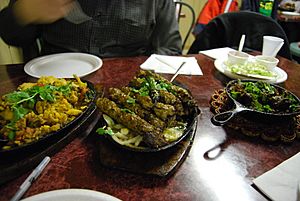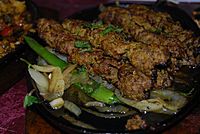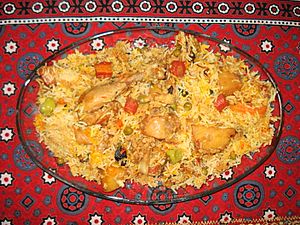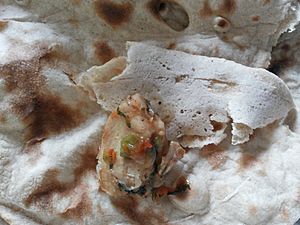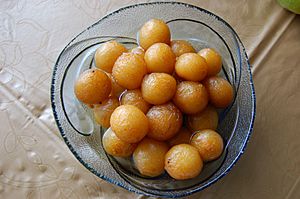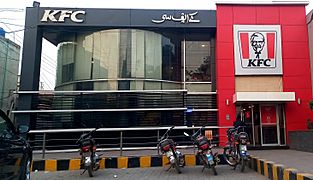Pakistani cuisine facts for kids
Pakistani cuisine is a mix of different cooking styles from South Asia, Central Asia, and Western Asia. It also has influences from the old Mughal Empire. The food changes from one part of Pakistan to another because of the many different groups of people and their cultures.
Pakistani food follows Halal rules. This means that eating pork and drinking alcohol are not allowed, according to Islamic laws.
In big cities like Islamabad and Karachi, you can find many international foods and fast food restaurants. Sometimes, local and foreign recipes are mixed together, like in Pakistani Chinese food. People are also using more ready-to-use spice mixes (called masala) and ghee (a type of clarified butter) in their cooking.
Contents
How Pakistani Food Began
Pakistan's food traditions come from ancient cultures like the Indo-Aryans and Iranic people, along with Muslim cooking styles. People in this region were already cooking special dishes as far back as the Bronze Age, during the Indus Valley Civilization. Around 3000 BCE, plants like sesame and eggplant were grown here. Spices like turmeric, cardamom, black pepper, and mustard were also harvested. For over a thousand years, wheat and rice were the main foods in the Indus Valley.
When Islam came to South Asia through trade and conquests, it greatly changed the local food. Because most people in Pakistan are Muslim, they strictly follow Islamic food rules. This means they do not eat pork or drink alcohol. Instead, Pakistani food focuses on other meats like beef, lamb, chicken, and fish. They also use many different fruits, vegetables, and dairy products.
Spices and Flavors
Pakistani dishes are known for being very flavorful and sometimes spicy. Many dishes use a good amount of oil, which makes them taste richer. Some of the most common spices used across Pakistan are brown cardamom, green cardamom, cinnamon, cloves, nutmeg, mace, and black pepper. Cumin seeds, chili powder, turmeric, and bay leaves are also very popular. In the Punjab area, coriander powder is often used in spice mixes. Garam masala, which is a mix of aromatic spices, is a favorite in many Pakistani dishes.
Food from Different Regions
Balochistan
Balochi food comes from the Baloch people. It is different from other Pakistani and Iranian foods. Some popular Balochi dishes include Balochi sajji (lamb or chicken cooked on skewers with rice inside), mutton rosh (mutton chops), and dampukht (meat cooked slowly in its own fats).
Khyber Pakhtunkhwa
In Pashtun cooking, rice dishes and kebabs are very important. Lamb is eaten more often here than in other Pakistani foods. Kabuli palaw, chapli kabab, tika, and mutton karahi are the most famous dishes. Pashtun and Balochi foods are usually not very spicy.
Kalash
The Kalash people have a special food culture with different kinds of breads and cheese. Their famous bread is made with flour and various nuts. Some breads are bilili (walnut bread) and kurau (flour baked with crushed grape juice).
Punjab
People in Punjab share many similar food traditions. Bong paye (made from the legs and joints of animals), nihari (a slow-cooked meat dish), and murgh chanay (chicken and chickpeas cooked slowly in butter) are considered true Punjabi specialties.
Sindh
Sindhi food comes from the Sindhi people. It is known for being spicy and has many chicken dishes. Karhi, daal pakwan, and Palo fish are popular.
Karachi
Karachi's food is a mix from all regions of Pakistan. However, it is strongly influenced by the Mughlai and Deccani foods of Muslims who moved from India after 1947.
Gilgit-Baltistan
Gilgiti food comes from the Gilgit-Baltistan region. Famous Gilgiti dishes like Chapshoro are now popular across Pakistan. Mumtu, which are tiny dumplings, are often served with yogurt, parsley, black pepper, vinegar, and chili sauce.
Meal Times
Pakistanis usually eat three meals a day: breakfast, lunch, and dinner. In the evening, many families have tea with baked or fried snacks. During the holy month of Ramadan, people eat before sunrise (suhur or Sehar) and after sunset (iftar). It is polite to eat only with your right hand, which is a tradition in many Asian cultures. Many Pakistani families, especially when they have guests, eat sitting around a cloth called a Dastarkhān, which is spread on the floor. In Pakistan, some street food places serve food on a takht, which is a raised platform where people sit cross-legged to eat.
Breakfast
A typical Pakistani breakfast, called nāshtā, includes eggs (boiled, scrambled, fried, or omelette), bread or roti, parathas, sheermal with tea or lassi, kulcha with chole, qeema (minced meat), fresh fruits, milk, honey, butter, jam, shami kebab, or nuts. Sometimes, baked goods like bakarkhani and rusks are eaten. On holidays and weekends, halwa poori and chickpeas are popular. In Punjab, sarson ka saag (mustard leaves) and maakai ki roti (cornbread) are local favorites. Punjabi people also enjoy khatchauri, a savory pastry with cheese. Meat dishes are also eaten for breakfast, especially on holidays. A traditional Sunday breakfast might be Siri-Payay (head and feet of lamb or cow) or Nihari (a dish cooked overnight to make the meat very tender).
Lunch
A typical Pakistani lunch has meat curry or shorba (soup) with rice or roti. Daal chawal (lentils and rice) is a very common lunch dish. Breads like roti or naan are usually for dinner but are now more common during the day. Rice can also be served for dinner. Popular lunch dishes include aloo gosht (meat and potato stew) or any vegetable with mutton. Chicken dishes like chicken karahi are also popular. Roadside food stalls often sell lentils and tandoori rotis, or masala stews with chapatis. People living near rivers also eat fish for lunch, sometimes cooked in a tandoor.
Dinner
Dinner is the main meal of the day when the whole family eats together. Dishes that take more time to prepare and are more flavorful, like biryani, nihari, pulao, kofte, kebabs, qeema, and korma, are made. Lentils are also a common dinner food. These are served with bread like roti or naan or with rice, along with yogurt, pickle, and salad. Dinner might end with fresh fruit or, on special occasions, traditional desserts like kheer, gulab jamun, shahi tukray, gajraila, qulfi, or ras malai.
Snacks and Fast Foods
Pakistani snacks are quick to make, spicy, and usually fried. They are eaten in the evening or morning with tea, or as a side dish with meals. Snacks can be part of local culture and vary in popularity. They are often sold by street vendors on footpaths and at railway stations, but also served in restaurants. Some typical snacks are Dahi Bhala, Aloo tikki, chaat & Samosa Chaat, Bun kebab, Chana Masala, Chapli kebab, Shami kebab, Seekh Kebab, Malai Tikka Kebab, Reshami Kebab, Pakora, and Papar. Other snacks include Katchauri, pakoras (made from chickpea flour), Gol Gappay, Samosas (vegetable or beef), Bhail Puri, Daal Seu, Panipuri, and egg rolls. Nuts like pistachios and pine nuts are also often eaten at home.
Main Dishes
In Pakistan, main dishes are usually served with wheat bread (roti or naan) or rice. Salad is typically a side dish, not an appetizer. Fresh fruit or desserts are eaten at the end of a meal. Meat is very important in Pakistani food, much more than in other South Asian foods. An average Pakistani eats three times more meat than an average Indian. The most popular meats are goat, lamb, beef, and chicken. These are especially popular for kebab dishes or the classic beef shank dish nihari. Seafood is not eaten much, but it is very popular in coastal areas like Sindh and the Makran coast of Balochistan.
Dishes with or without meat, combined with local vegetables like bitter gourd, cauliflower, eggplant, okra, cabbage, potatoes, rutabaga, saag, and chili peppers, are very common for everyday meals. A good example is aloo gosht (meaning "potatoes and meat"), a homemade stew with spiced meat and potatoes, cooked in many homes. Korma is a classic dish from the Mughal era, made with chicken or mutton, usually eaten with naan or other bread, and is very popular in Pakistan.
Vegetable and Legume Dishes
Many vegetarian dishes are popular in Pakistan. They are often cooked with traditional spices and flavors like chilies, turmeric, garlic, ginger, cumin, cloves, cinnamon, and fennel seeds. Vegetable and legume dishes are very popular. Dishes like Baingan bartha (eggplant dish) and Sarson da saag (mustard greens) are common in most homes. Aloo mutter is made with potatoes and peas.
Many vegetables are grown in Pakistan depending on the season. These are cooked into tasty and spicy curries for lunch or dinner. Some vegetable dishes, like aloo paratha and channa puri, are also eaten for breakfast.
Meat Dishes
Meat dishes in Pakistan include beef, lamb, chicken, and seafood. Chicken karahi is a famous chicken dish. Meat is usually cut into 3 cm cubes and cooked in a stew. Minced meat is used for Kebabs, Qeema, and other meat dishes. Meat dishes are also cooked with pulses, legumes, and rice.
Barbecue and Kebabs
Meat cooked on grills has been important in Pakistan for centuries. Kebabs are a main food in Pakistani cuisine today, and you can find many different kinds all over the country. Each region has its own kebabs, but some, like the Seekh kebab, Chicken Tikka, and Shami kebab, are very popular across the country and in other parts of South Asia.
Pulses
Different kinds of pulses or legumes are an important part of Pakistani food. Lentils (called daal) and chickpeas (called channa or chanay ki daal) are popular in home cooking. They are usually considered inexpensive foods. Because of this, they are not usually served to guests at dinner or on special occasions. However, meat is often combined with lentils and pulses, in simple dishes or in more complex ones like haleem.
Beans like black-eyed peas (lobia) and kidney beans (rajma) are sometimes served in a tomato-based masala sauce, especially in Punjab.
Chickpeas, red kidney beans, and other legumes are also popular. They are usually cooked in a spicy gravy and served with rice or traditional flatbread (roti). Chickpeas, known as channa, are also a common breakfast food when served with puri. Channa chaat is another favorite street food and iftaar dish. It is made of chickpeas, chopped onions, tomatoes, and chilies, seasoned with spices (chaat masala) and tamarind paste.
There are many kinds of lentils, called daal, eaten in Pakistan, often with rice. Daal chawaal (lentils and rice) is a popular comfort food in many Pakistani homes.
Rice Dishes
Pakistan grows and eats a lot of rice. Basmati is the most popular type of rice.
Dishes made with rice include many kinds of pulao:
- Maash pulao - A sweet and sour pulao with mung beans, apricots, and bulgur (cracked wheat). It is only vegetarian.
- Matar pulao - Pulao made with peas.
- Murgh pulao - Chicken and stock are added, making the rice brown.
- Yakhni pulao - Meat and stock are added, also making the rice brown.
- Kabuli Palaw - An Afghan dish popular in Pashtun areas of Pakistan like Khyber Pakhtunkhwa and Balochistan. It is a type of pilaf with steamed rice mixed with raisins, carrots, and lamb.
Biryani is a very popular dish in Pakistan, with many varieties like Lahori and Sindhi biryani. Tahiri, a vegetarian biryani, is also popular. All main dishes (except rice dishes) are eaten with bread. To eat, a small piece of bread is torn off with the right hand and used to scoop up small portions of the main dish. Pickles made from mangoes, carrots, lemons, etc., are also commonly used to add more flavor to the food.
In Khyber-Pakhtunkhwa, large meals with spiced rice and slow-roasted lamb are often served to important guests. These pulaos often have dried fruit, nuts, and whole spices like cloves, saffron, and cardamom. Kabuli Palaw is very popular in Pashtun areas of Western Pakistan. These rice dishes originally came from Central Asia and the Middle East.
Types of Bread
Pakistanis eat breads made of wheat flour every day. Pakistan has many different kinds of breads, often made in a traditional clay oven called a tandoor. Tandoori cooking is common in both rural and urban Pakistan, and also in nearby India, Iran, and Afghanistan. Some of these breads are:
- Chapati - The most common bread made in homes without a tandoor. Chapatis are cooked on a flat pan called a 'tava'. They are made of whole-wheat flour, are thin, and do not have yeast. A very thin and large version is called 'romali roti'.
- Kandahari Naan - A long, salty naan from Western Pakistan, often eaten with Peshawari Karahi or Chapli Kebab.
- Kulcha - A type of naan usually eaten with chickpeas and potatoes, popular in cities in Punjab.
- Naan - In Urdu, the word Naan means bread. Unlike chapatis, naans are thicker, usually made with yeast and white flour. Some kinds like Roghani and Peshwari naan might have sesame seeds. Naans are usually not made at home because they need a tandoor. Many kinds of plain and stuffed naans are found across Pakistan, with each region having its own specialty. Naan is a versatile bread and can be eaten with almost anything. For example, 'saada naan' or 'plain naan' is often served with Siri-Payay or Nihari for breakfast.
- Paratha - A flat, layered bread made with ghee or cooking oil, usually cooked on a 'tava'. A tandoor version is also common in rural areas. Parathas are similar to pastry dough. They probably started in Punjab, where farmers ate a big breakfast of parathas with fresh butter and buttermilk to get ready for work. Now, parathas are a common breakfast food everywhere. Besides the plain layered one, many stuffed versions like 'Aloo ka Paratha' (potato), 'Mooli ka Paratha' (radish), and 'Qeemah ka Paratha' (ground meat) are popular.
- Puri - A breakfast bread made of white flour and fried. It is usually eaten with sweet semolina halwa or gravy (made from chickpeas and potatoes). Puri is mostly an urban food in Pakistan. However, Halwa Puri is now a favorite weekend or holiday breakfast in urban areas, sold by street vendors or in special breakfast shops.
- Roghani Naan (meaning Buttered Naan) - A popular Naan sprinkled with white sesame seeds and cooked with a little oil.
- Roti - This bread is very popular all over Pakistan. Tandoori rotis are baked in a clay oven, called a tandoor, and eaten with almost anything. In rural Pakistan, many homes have their own tandoors, while others use a shared one. In urban Pakistan, bread shops or "nanbai"/"tandoor" shops are common and sell fresh, tandoor-baked breads.
- Sheermal – A saffron-flavored traditional flatbread. It is a festive bread made with milk ('sheer') and butter, with added candied fruits. Sheermal is often an important part of food served at weddings, along with Taftan. It is often sweet.
- Taftan - This is a leavened flour bread with saffron and a little cardamom powder, baked in a tandoor. The taftan made in Pakistan is a bit sweeter and richer than the one made in Iran.
Desserts
Popular desserts include Peshawari ice cream, sheer khurma, qulfi, falooda, kheer, Firni, zarda, shahi tukray, and rabri. Sweet treats are eaten on various festive occasions. Some of the most popular are gulab jamun, barfi, ras malai, kalakand, jalebi, and panjiri. Pakistani desserts also include many kinds of halvah, such as multani, hubshee, and sohan halvah.
Kheer made from roasted seviyaan (vermicelli) instead of rice is popular during Eid ul-Fitr. Gajraila is a sweet made from grated carrots, boiled in milk, sugar, cream, and green cardamom, topped with nuts and dried fruit. It is popular in Pakistan and other parts of South Asia.
Tea Varieties
Pakistanis drink a lot of tea, which is called "chai." Both black tea (with milk) and green teas are popular, and there are different kinds in different parts of Pakistan.
- In Gilgit-Baltistan and Chitral, and near the Chinese border, salty Tibetan-style butter tea is drunk.
- Doodh Pati Chai is made by cooking tea leaves with milk and sugar, sometimes with cardamom for a nice smell. It is very sweet.
- "Kashmiri chai" or "noon chai" is a pink, milky tea with pistachios and cardamom. It is mainly drunk on special occasions, at weddings, and in winter, sold at many kiosks.
- "Sabz chai" or "kahwah" is a green tea often served after every meal in Kashmir, Khyber Pakhtunkhwa, and the Pashtun areas of Balochistan. It is served with saffron and nuts.
- Sulaimani chai is black tea served with lemon.
Drinks
Besides tea, there are other drinks in Pakistani cuisine. All of them are non-alcoholic because drinking alcohol is not allowed in Islam. In the 20th century, drinks like coffee and soft drinks also became popular. It is very common to have soft drinks with Pakistani meals today.
- Almond sherbet - Made with almonds.
- Baraf Gola - Frozen ice in a cup with syrup on top.
- Kashmiri chai/Gulabi chai - A milky tea known for its pink color, can be sweet or salty.
- Lassi - Milk with yogurt, can be sweet or salty.
- Lemonade (Limu pani)
- Qehwa - Green tea with cardamom.
- Sardai - A mix of different nuts and raisins.
- Sathu - A famous drink from Punjab.
- Sherbet (syrup mixed in water)
- Sherbet-e-Sandal - Drink made from sandalwood essence.
- Sikanjabeen - Lemonade (mint is also added).
- Sugarcane juice (Ganney ka ras)
- Thaadal - A sweet drink from Sindh.
Halal Food Rules
Muslims who follow Islamic law eat foods and drinks that are halal, meaning they are allowed. These rules say what foods are allowed and how they must be prepared. The rules mostly apply to different types of meat.
Outside Influences
Besides traditional food, fast food is also very popular across Pakistan. In big cities, you can find many international fast food restaurants like KFC, McDonald's, Pizza Hut, Subway, and Burger King.
Sometimes, many people in Pakistan eat out at restaurants that serve foreign-influenced food, such as Western, Arab, and Chinese dishes. Many Western and Chinese restaurants and fast food places are found in all urban parts of Pakistan. In Punjab and Sindh provinces, many American, European, and British restaurant chains have opened in cities like Karachi, Lahore, Faisalabad, Islamabad-Rawalpindi, and Peshawar. Marketing and advertisements have made these places popular social spots for Pakistanis.
Outside Pakistan, Pakistani food is common in countries where many Pakistani communities live.
Pakistani food uses fresh, hand-ground spices. Ghee is used, but the main part of a meal is usually meat (beef, lamb, chicken, goat, or fish). Vegetables are used less often. Surprisingly, Pakistani food also uses a lot of olive oil. Even though vegetables are used less, there are still many vegetarian dishes. Since the food is very similar to Punjabi-style cooking, tikka, simmered dals, tawa sabzi, and chaat are also found here.
Images for kids
See also
 In Spanish: Gastronomía de Pakistán para niños
In Spanish: Gastronomía de Pakistán para niños


